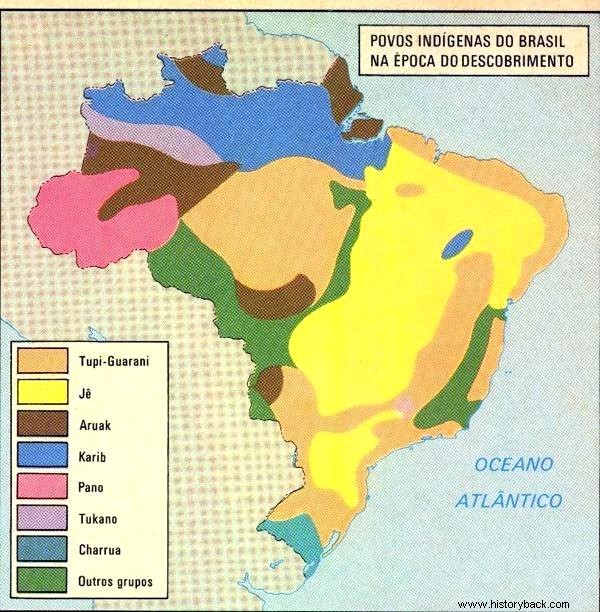The Brazilian Indians today form a contingent that represents about 0.47% of the Brazilian population.
According to the IBGE census (2010), there are 896,917 indigenous people in the country , of which about 60% live on indigenous lands officially recognized by the federal government.
Of this number, 324,834 live in cities and 572,083 in rural areas. The northern region has the largest indigenous population in the country.
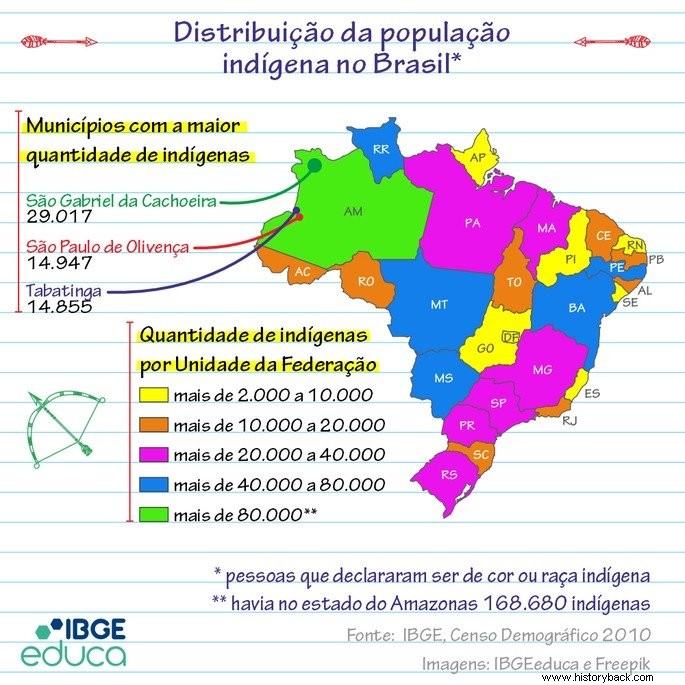
Indigenous peoples in Brazil
According to the IBGE census (2010), there are 305 ethnic groups in Brazil. Among them, there are two main trunks:
Macro-Jê :which include the Boróro, Guató, Jê, Karajá, Krenák, Maxakali, Ofayé, Rikbaktsa and Yatê groups.
Tupi :where are the Arikém, Awetí, Jurúna, Mawé, Mondé, Mundurukú, Puroborá, Ramaráma, Tuparí and Tupi-Guarani.
The 10 main indigenous tribes in Brazil
According to data from the Instituto Socioambiental (ISA), the tribes that stand out the most by the number of inhabitants are:
- Guarani :originating from the trunk of the Tupi-Guarani linguistic family, the Guarani have around 85,000 inhabitants in the country. They live in different states of Brazil and are divided into three groups:kaiowá, mbya and ñadevaesse.
- Ticuna :belonging to the Ticuna linguistic family, it has about 50 thousand inhabitants - who are in the Amazon, especially on the banks of the Solimões River. They are considered the largest indigenous group living in the region.
- Caingangue :from the core of the Macro-Gê linguistic family, the Caingangues gather around 45,000 people. They are in four Brazilian states:São Paulo, Paraná, Santa Catarina and Rio Grande do Sul.
- Macuxi :from the Karib linguistic family, the Macuxis are largely found in the state of Roraima. About 30,000 indigenous people live in isolated villages and small dwellings across the state.
- Guajajara :from the trunk of the Tupi-Guarani family, the 27,000 existing Guajajaras live in the state of Maranhão.
- Terena :from the Arawak linguistic family, there are about 26 thousand people of this ethnic group in Brazilian territory. They are found in the states of Mato Grosso, Mato Grosso do Sul and São Paulo.
- Yanomami :from the Yanomami linguistic family, this group comprises around 26,000 people in the states of Amazonas and Roraima.
- Xavante :Originating from the Macro-Jê linguistic family, the Xavante have a population of 18,000, which are concentrated in indigenous reserves in the state of Mato Grosso.
- Potiguara :belong to the trunk of the Tupi-Guarani linguistic family. The potiguaras total about 18 thousand people in the states of Paraíba, Ceará, Pernambuco and Rio Grande do Norte.
- Pataxo :from the Pataxó linguistic family, this group comprises about 12 thousand people in the states of Bahia and Minas Gerais.
Indigenous culture
The indigenous culture is diverse, and each ethnic group has its own habits and a way of relating to the world. Yet many tribes share similar ways of life, rituals, and social organization.
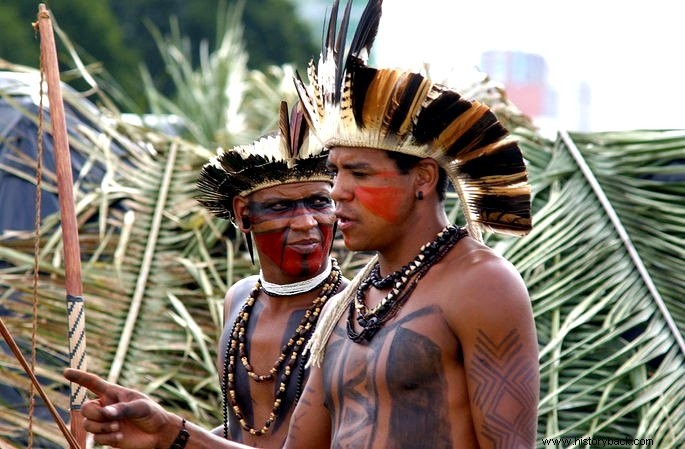
Indigenous languages
Currently, there are 274 indigenous languages in Brazil, according to the 2010 IBGE census. Many of them emerged from the Tupi and Macro-Jê linguistic trunks.
Orality is notorious in indigenous communities, and much of the culture is transmitted this way.
Social organization in indigenous societies
In general, the Indians of Brazil live in collective housing, sharing huts or malocas, usually made of wood and straw.
These large sites are undivided and often house several families.
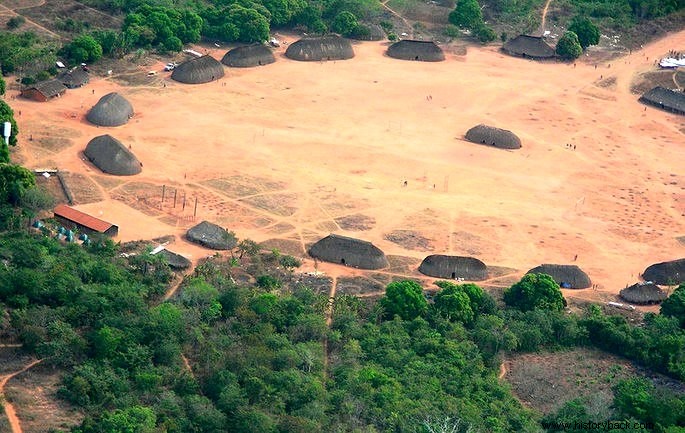
The division of tasks is very clear in indigenous societies, so that men are in charge of hunting, defending the territory and building.
The women, on the other hand, are in charge of planting and harvesting food, in addition to taking care of the children and producing the utensils and ornaments used by the tribe.
Indigenous religion
Indigenous religion, roughly speaking, is pantheistic, where there is not only one figure related to a creator being. In religious rituals, the Indians tend to revere ancestral beings and nature.
The shaman, also called shaman, is responsible for mediating between the spiritual and earthly worlds. Rituals vary between tribes and can occur by taking certain substances (usually hallucinogenic), which will make the connection between the spiritual and material worlds.
Indigenous art
Indigenous art is extremely rich and is manifested in music, dance, feather art, basketry, ceramics, weaving and body painting.
The use of colors and certain materials are related to rites of passage, agricultural and everyday celebrations.
Among the tribes of Brazil, we can mention especially the Marajoara ceramics, which use countless geometric shapes to compose domestic utensils.
History of Brazilian Indians
First inhabitants of Brazil, at the time of the discoveries there were about 5 million indigenous people spread across the country.
When the Portuguese arrived in Brazil, they found an indigenous population that inhabited the coast. The Indians that Cabral encountered in Bahia belonged to the Tupi linguistic group.
At first, the contacts between Indians and whites were reasonably cordial and marked by barter, that is, the exchange of products.
The work of felling the pau-brasil and preparing the wood for shipment was done by the indigenous people, in exchange for clothes, necklaces, mirrors, knives, saws and axes.
When the Portuguese implemented a colonial system and intended to transform the Indian into an agricultural slave, he segregated them on the mills and deprived them of hunting, fishing and fighting enemies. Thus, a war between whites and Indians began.
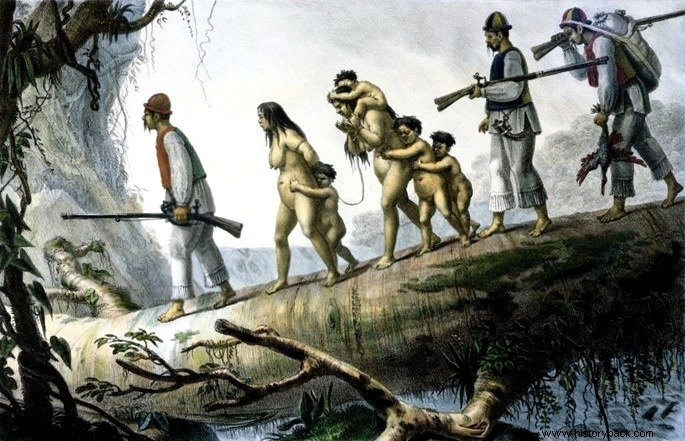
Indigenous populations lost their land and suffered a progressive annihilation.
The captaincy of São Vicente (São Paulo), in the 16th and 17th centuries, was the greatest example of this. From there, the Indian hunting flags started, which promoted real wars of extermination.
Indigenous society in colonial times
The Brazilian Indian lived in a primitive community regime, where community production prevailed.
Work was divided according to sex and age. The women took care of the farming, the children and the cooking. Mainly maize, beans, manioc, yams, sweet potato, pumpkin and tobacco were grown.
Men hunted, fished, built tabas, fought and prepared the soil for farming.
The food obtained from hunting, fishing, gathering and farming was shared among all members of the community.
The Indians lived in hollows, where they slept in hammocks and mats. Hollows were built of thatch or palm tree. They were distributed around a large circle, where the Indians had their meals and their religious ceremonies.
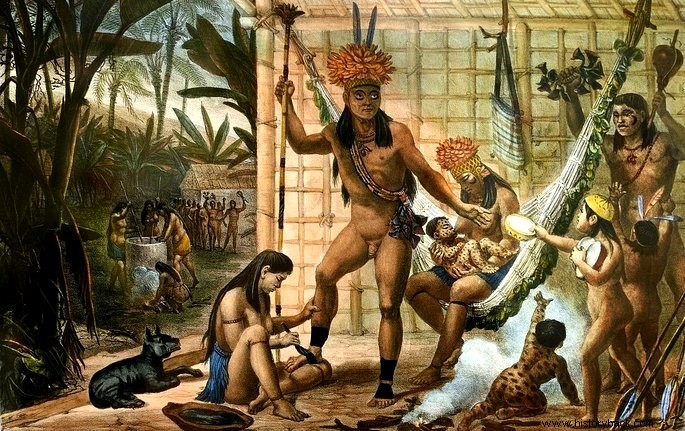
The set of hollows formed the village or taba. Several tabas formed a tribe and a set of tribes formed a nation.
The Indians worshiped several gods, admitted a superior trinity composed of Guaraci (the sun), Jaci (the moon) and Perudá or Rodá (god of love). The religious head of the village was the shaman, who had magical powers.
They worshiped the forces of nature (wind, rain, lightning, thunder) and were afraid of evil spirits.
One of these evil spirits, for example, was the Jurupari, which caused nightmares and tightened the throats of children at night.
The marriage was monogamous, although the chiefs had as many wives as they could support, as the number of wives was a factor of prestige in certain tribes.
When a young man wished to marry a girl from another group, he worked for his future father-in-law for some time.
For the Carajás, a young man who carried a very heavy wooden trunk was considered fit for marriage, and among the Curina, the bride and groom had to endure a whipping.
Anthropophagy among the Indians
When the Indians needed new hunting grounds, due to the scarcity of animals, or when they wanted more fertile lands, they resorted to war.
Thus, generation after generation, a warrior ideal of masculinity, courage and strength was developed.
Anthropophagy among the Indians was not caused by the absence of food. The Indians devoured their fellows for two reasons:revenge and ancestor worship.
In some tribes the members of the tribe who died of natural death were also devoured. They believed that in this way they assimilated the virtues of the deceased relative.
Indigenous nations in colonial times
Since colonial times, there has been an interest in getting to know the indigenous people, in order to make them allies against invasions by other Europeans.
Thus, the first way to understand the indigenous people was to gather them into linguistic groups or large nations, from which they stood out:
- Tupi - spread across the Atlantic coast and several areas of the interior;
- Jê or Tapuia - lived in the Brazilian Central Plateau;
- Aruak - inhabited, to a large extent, in the Amazon Basin;
- Karib - occupied the north of the Amazon Basin.
Indigenous cultural heritage
The Brazilian people have several customs inherited from the indigenous people. Among them are:
- the use of the hammock;
- the use of corn, manioc, guarana and other native fruits;
- the use of various medicinal herbs;
- the manufacturing techniques of canoes, rafts and straw and vine artifacts;
- the use of burning the gardens before replanting, etc.
The Portuguese language spoken in our country has a multitude of words of indigenous origin, such as Iara, Jaci, Itu, Itapetininga, Anhanguera, tapioca, beiju, pamonha, gamela, puçá, arapuca, among others.
The Indians contributed to the formation of the Brazilian people. In colonial society, the union between Indians and whites - at first illegitimate - was called "mameluco" or "caboclo". In turn, the union between Indians and blacks, which occurred to a lesser extent, was called "cafuzo" or "caburé".
Also read:
- Guarani Indians
- Indigenous culture
- Tupi-Guarani culture
- Brazilian indigenous art
- Formation of the Brazilian people:history and miscegenation
- Indigenous Slavery in Colonial Brazil
- Indian Day
- Indigenous games

